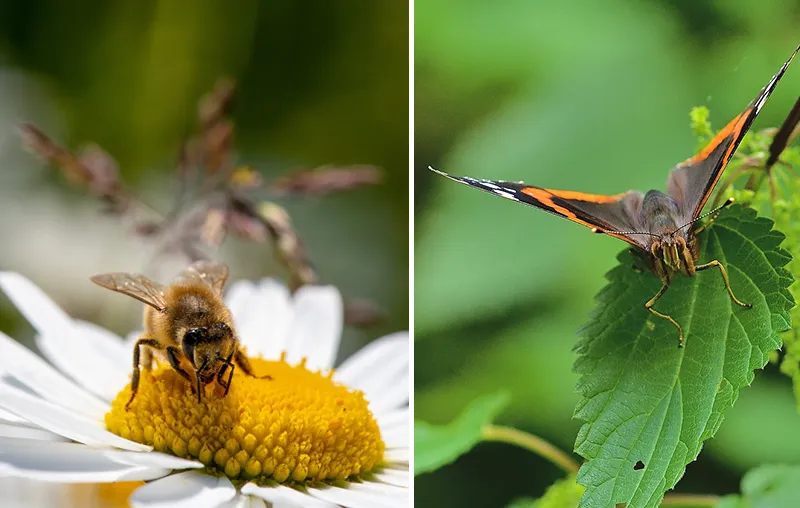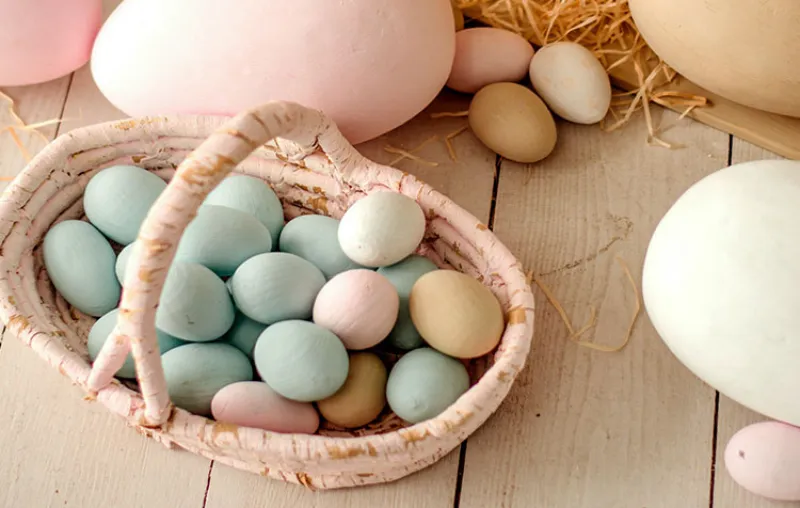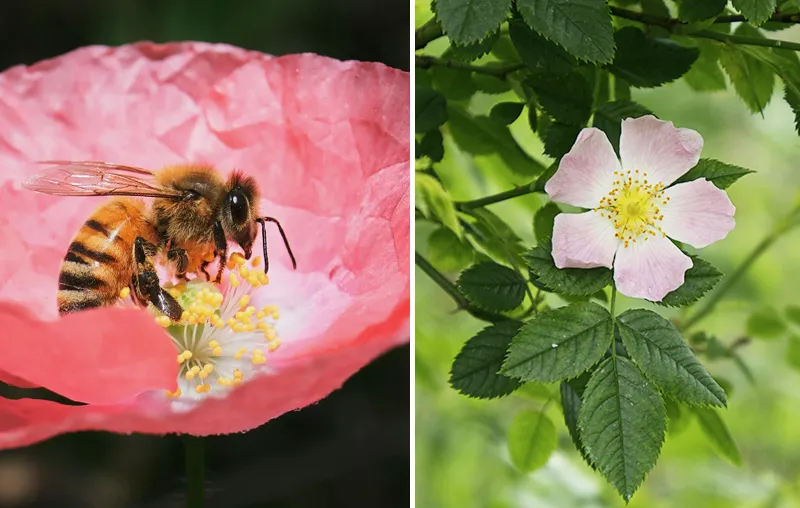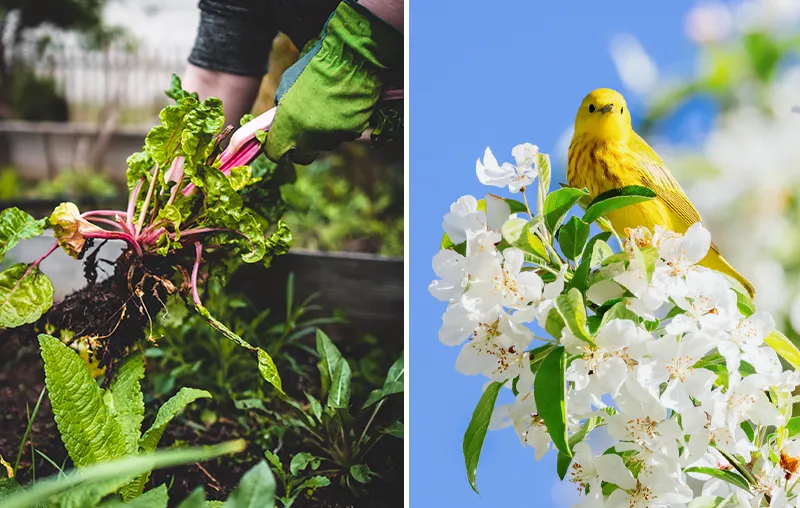Which weeds are actually insect-friendly and should therefore not be weeded? If you're looking for a clear answer to this question, you've come to the right place!
Many people describe a plant as a weed if it grows unplanned in the garden, appears useless at first glance, persists and spreads quickly, is perceived as unsightly in the flower bed or on the lawn or competes with deliberately placed plants. In short: weeds are often unwanted accompanying vegetation that seemingly has to be fought by all means.
Unfortunately, very few people realize that weeds absolutely do not deserve their bad reputation. Because on closer inspection, most of these wild herbs are above all one thing: absolute insect magnets with high ecological value.
In this article, you will find out which supposed "weeds" bees, butterflies, caterpillars and hoverflies love. Use this knowledge to better appreciate them and make them part of your insect-friendly garden to look at. Let's go!
Reasons: Why You Should Let Bee-Friendly Weeds Thrive
So whether weeds or not is subjective. What may be a nuisance for one person may be considered a valuable habitat by another. But in my opinion, there are many good arguments for no longer classifying any native plant as a weed, as each of them their function has.
And by that I don't just mean that they Keep snails away from vegetables, tasty, beautiful, easy to care for or a well-tried medicinal plant - and therefore useful for us humans.
I see them above all as important element in the preservation of our Biodiversity. For example, as an essential Food source for bees, as a protective Habitat for beetles and as Nutrient provider for healthy, fertile and populated soils.
Not to remove so-called weeds, but to deliberately to leavehelps above all to improve the global Insect Die-Off to stop. And since we have to rely on the Pollination performance of the little animals, this measure is ultimately also important for us humans. Highly useful.
Bee-Friendly Weeds #1-10: Wild Plants You Shouldn't Remove to Support Insects
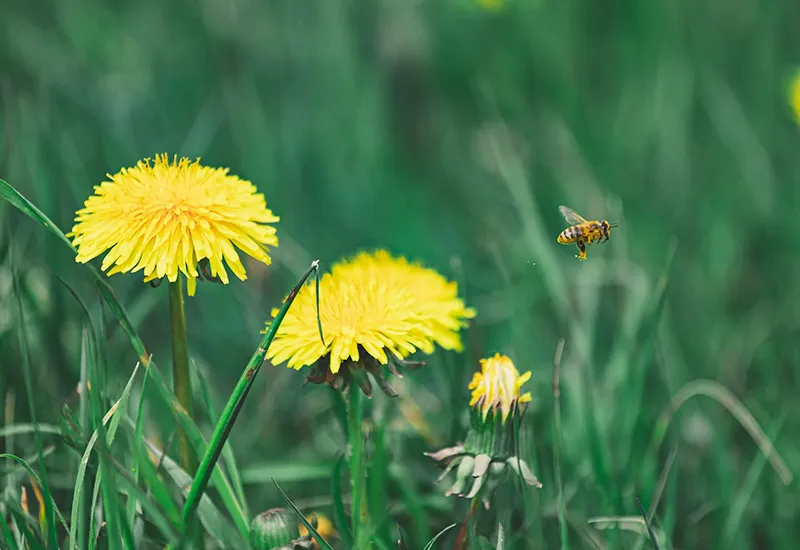
Weed seeds lurk in the garden soil, develop via root runners or fly into the garden with the wind. So it's no wonder that some hobby gardeners have a lifelong fierce war against the dreaded weeds lead.
Do you recognize yourself there? Then perhaps this article can also help you to let go of something, your Reduce stress levels, the Accepting plants and attract even more wild bees, butterflies, dragonflies, beetles and grasshoppers to your garden. 😉
The following supposed weeds attract insects magically on. I will now show you why this is the case, how the respective plant blooms and, as an extra motivation, I will also briefly introduce you to the additional everyday benefits it has in store for you.
1. Common Dandelion (Taraxacum officinale)
Everyone knows the dandelion with its striking, yellow flowers! If not from the earlier TV series of the same name with Peter Lustig, then of course from the garden or the meadow next door.
The edible seed weed represents for over 112 native wild bee species alone and countless other pollinators are an important source of pollen and nectar. Many are even specialized on the "weeds". An absolute MUST, therefore, for everyone Natural garden.
Important facts at a glance:
- Insects: Important for wild bees, butterflies, caterpillars, hoverflies and beetles.
- Flower: Yellow flower heads that bloom from April to June.
- Areas of application: e.g. for salad, as Honey substitute*, Tea* or remedies.
2. Ground Ivy (Glechoma hederacea)
Surely you are also familiar with the wintergreen groundsel with its beautiful, purple flowers! This insect-friendly weed is particularly common along roadsides and is of interest to a large number of wild bees and a few butterfly species.
You should therefore never remove the plant. Instead, you can use it as a bee-friendly ground cover or for your Bee pasture in the garden - and even eat the leaves and flowers.
Wenn du magst, bekommst du den Gundermann auch here at the Horstmann nursery*.
Important facts at a glance:
- Insects: Important for wild bees, butterflies, beetles and hoverflies.
- Flower: Purple lip flowers that bloom from May to June.
- Areas of application: e.g. for tea, herb butter or as a medicinal plant or spice.
3. Ground Elder (Aegopodium podagraria)
Because ground elder has an extreme urge to spread and belongs to the stubborn root weeds most garden owners are at war with the plant.
But even if goutweed is notorious on the one hand, the edible (only the roots are poisonous!) insect-friendly weed provides the little garden dwellers:inside Nectar and pollen. Around 84 species of hoverflies and 31 species of wild bees, as well as some butterflies and beetles, enjoy the white blossom.
Important facts at a glance:
- Insects: Important for wild bees, hoverflies, butterflies, caterpillars and beetles.
- Flower: White umbels that flower from May to August.
- Areas of application: e.g. for salads, soups, as a spinach substitute or as a Healing tincture*.
4. White Clover (Trifolium repens)
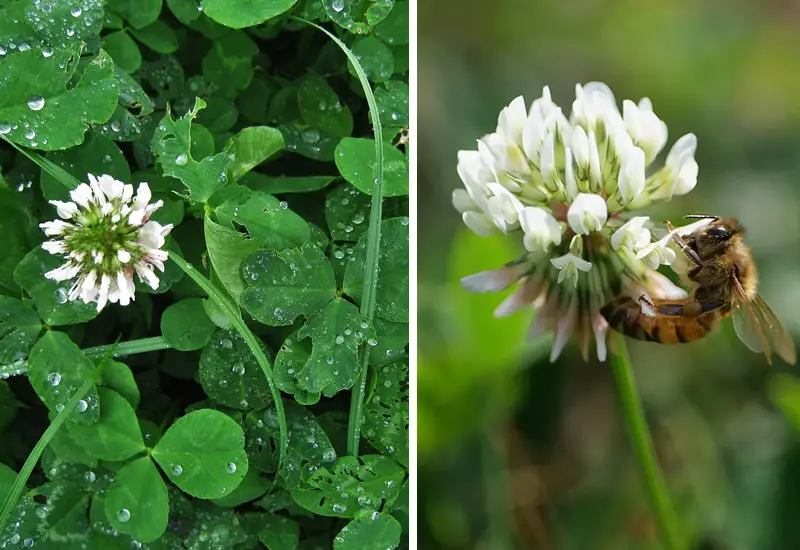
In fact, white clover among the most common weeds on lawns. Personally, however, I am a real fan of the native white clover, which I also tolerate and allow to flower on my small lawn at home.
For me, clover is a great and valuable plantbecause it looks really beautiful with its nectar- and pollen-rich white flowers and also provides a habitat for 46 species of wild bees, many butterflies and a few other insects.
Incidentally, the flowers and leaves, as well as the seeds and seedlings of the weed are edible.
Important facts at a glance:
- Insects: Important for wild bees, butterflies, caterpillars and beetles.
- Flower: White, spherical inflorescence that flowers from May to October.
- Areas of application: e.g. as a medicinal plant, as well as a salad, soup, syrup or vegetable.
5. Daisy (Bellis perennis)
How beautiful are daisies, please? Unfortunately, the supposed weed bothers many people who want a perfect lawn. For me, the self-seeding, tried and tested medicinal plant however, is anything but a useless weed.
I am happy about every flowering of the perennial on the lawn, because I am aware that many insects - including around 75 wild bee species - the daisies need.
Leave the bee-friendly weeds (e.g. as part of the "No Mow Mays") so feel free to grow. You yourself will not only benefit from relaxing Sounds of nature, like the Humming and humming of insects, but you can also eat the leaves, buds and flowers of the daisy.
Important facts at a glance:
- Insects: Important for wild bees, hoverflies, caterpillars, butterflies and beetles.
- Flower: White, red or pink capitula flowers that bloom from March to November.
- Areas of application: e.g. as a tea, in salads, spreads or as an edible topping.
6. Ribwort Plantain (Plantago lanceolata)
One of the insect-friendly weeds is ribwort plantain, which you will certainly recognize with its pointed head and inconspicuous brown-white flowers. from the edge of the field or have already plucked them from your lawn.
Unfortunately, many people find the plant annoying and disruptive. On closer inspection, however, it becomes clear that it is an important habitat for caterpillars and bees in particular. high ecological value has. It is also a popular medicinal plant from which you can Eat all parts simply by following your heart.
Important facts at a glance:
- Insects: Important for caterpillars, wild bees, hoverflies and beetles.
- Flower: White to brown spiky inflorescence that flowers from April to September.
- Areas of application: e.g. in soups, salads, smoothies or as a seasoning herb.
7. Stinging Nettle (Urtica dioica)
I can understand why people dismiss stinging nettles as a weed when they occasionally see them. painful experiences with their stinging hairs.
However, if you want to take a quiet moment with the perennial herbaceous plant you will recognize that their green leaves and yellow flowers are particularly useful as food plants for caterpillars.
Since the weed edible and rich in vitamins and minerals, it is also increasingly used as an ingredient in salads and other meals. For a healthy lifestyle so ideal!
Important facts at a glance:
- Insects: Important for caterpillars, beetles and hoverflies.
- Flower: Yellow, panicle-like inflorescence that flowers from June to November.
- Areas of application: e.g. as Tea*spice, spinach alternative or salad topping.
8. Red Dead-Nettle (Lamium purpureum)
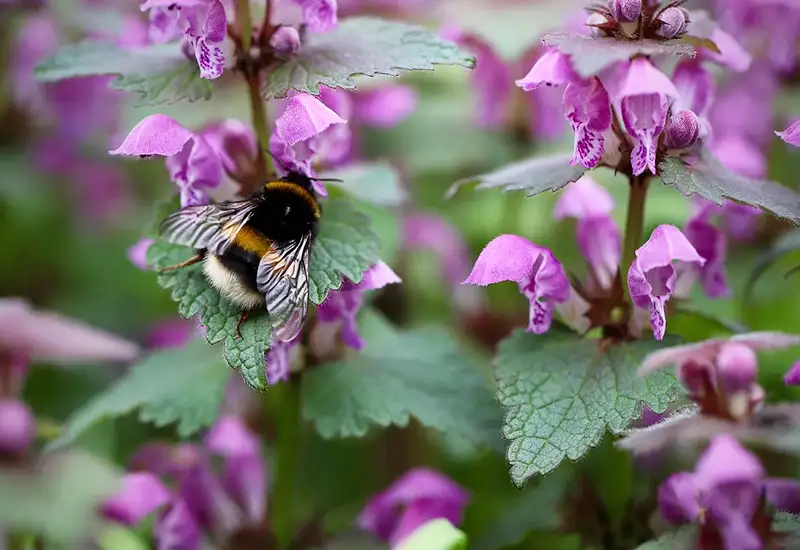
Among the rather useful, insect-friendly weeds is the purple deadnettle, which is widespread and which you are guaranteed to have seen before. by the wayside, in the field or just in your garden have seen.
Mit ihren pink bis lilafarbenen Blüten ist sie eine wunderschöne und super important insect plantas it is a food source for numerous wild bees, caterpillars and some other small animals.
The uncontrolled growth is also edible and can also be used as Ground cover provide faithful service in the garden.
Important facts at a glance:
- Insects: Important for wild bees, caterpillars, beetles, hoverflies and butterflies.
- Flower: Pink to purple whorled flowers that bloom from March to October.
- Areas of application: e.g. as a tea or poultice, as well as in salads or soups.
9. Wood Avens (Geum urbanum)
Now we come back to a real Bee magnets among the wild plants labeled as weeds. The yellow flowers of clovewort are in fact rich in nectar and pollen. Wild bees love the old medicinal plant - and some other insect species also like the plant.
Important facts at a glance:
- Insects: Important for wild bees, caterpillars, hoverflies and beetles.
- Flower: Yellow, five-part inflorescence that flowers from May to September.
- Areas of application: e.g. for salads, herb quark or as a spice and edible decoration.
10. Common Chickweed (Stellaria media)
Another insect-friendly weed is common chickweed. The flat-growing plant belongs to the so-called seed weeds and forms veritable carpets that drive some hobby gardeners to white heat.
With a view to the ecological value but I really like the native chickweed, as its lush green leaves and small white flowers provide a habitat for numerous wild bees and caterpillars, as well as other insects in the garden.
It is also easy to determine, edible and rich in nutrients.
Important facts at a glance:
- Insects: Important for wild bees, caterpillars, butterflies, hoverflies and beetles.
- Flower: White flower discs that bloom from March to October.
- Areas of application: E.g. in soups and smoothies or as an addition to salads.
Good to know: As the name suggests, chickweed is also very tasty to birds. What else you can do for a Bird friendly garden I'll show you how to do this in the linked blog post.
Weeds #11-20: Which Weeds Are Also Beneficial for Insects?
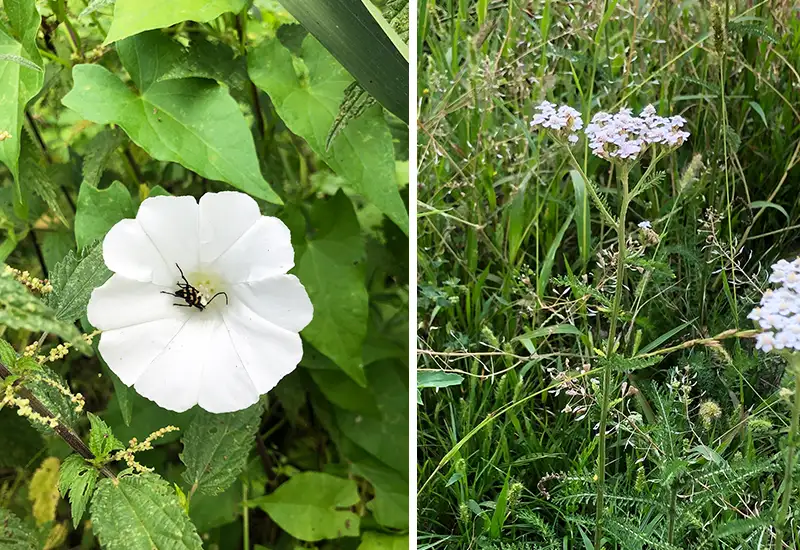
Before my hand falls off from writing: there are of course still many other "weeds"which bees and many other insects appreciate very much 😉 Since I also offer you these wild plants not withheld and would like to provide you with really extensive knowledge, I have listed them here once again:
- Field Bindweed (Convolvulus arvensis)
- Common Yarrow (Achillea millefolium)
- Creeping Buttercup (Ranunculus repens)
- Common Columbine (Aquilegia vulgaris)
- Common Mugwort (Artemisia vulgaris)
- Garlic Mustard (Alliaria petiolata)
- Greater Celandine (Chelidonium majus)
- Couch Grass (Elymus repens)
- Wild Carrot (Daucus carota)
- White Goosefoot (Chenopodium album)
Additional Tip: It's not just the small weeds that make a difference to the humming and buzzing in the garden. For example, take a look at the insect-friendly small trees which I have listed in a separate article.
Recognize and Embrace Bee-Friendly Weeds
Weeds never die - and that's a good thing! Because the plants to which we give this name are also Valuable and indispensable. Whether for the bee, the butterfly, for the entire ecosystem or for us humans.
So at least leave them here and there in your garden. Even if you don't benefit directly from it yourself. After all, you are ultimately helping to improve the global Stop species extinction. And we all have something of that!
"What is a weed? A plant whose virtues have never been discovered."
Ralph Waldo Emerson (more at Garden Quotes)
Möglicherweise hast du ja jetzt richtig Lust aufs naturnahe Gärtnern bekommen! Dann muss ich dir abschließend noch unbedingt das Buch "Wild & colorful: Designing natural gardens with native plants" an die Hand geben. Wenn du magst, get it here*.
Do you have any questions, tips or do you know of any other bee-friendly weeds that have not yet been mentioned here? Then I look forward to your comment.
Stay close to nature and insect-friendly,

PS: Did you know that you can also help the insect world with a self-built bee drinker a big favor? In the linked article I'll show you next how easy it is!

